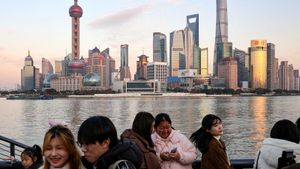South Korea is grappling with significant economic challenges, characterized by declining levels of life satisfaction, shifting dynamics within the semiconductor industry, and newly imposed tariffs from the United States impacting local manufacturers.
Life satisfaction among South Koreans has hit its lowest point since 2019, according to Statistics Korea's recent report. The annual assessment highlights a drop from 6.5 to 6.4 on a scale of 0 to 10, marking the first decrease since the COVID-19 pandemic recovery phase. This decline is particularly concerning as South Korea ranks 33rd out of 38 member countries of the OECD, trailing behind many of its peers. The report cites rising concerns among older demographics and low-income households as contributing factors to this decline. Indeed, households earning less than one million won per month reported the lowest satisfaction scores, underscoring the disparity faced by economically vulnerable segments of society.
Meanwhile, the semiconductor sector, once the crown jewel of South Korea's economy, is witnessing erosion in its competitive advantage, particularly against China. According to research published by the Korea Institute of Science & Technology Evaluation and Planning (KISTEP), South Korea has ceded ground across various technology domains, now trailing behind China by significant margins. A survey among 39 semiconductor experts revealed South Korea's score fell from 95% to 90.9% compared to China's rise from 90% to 94.1%. Experts believe this trend is detrimental and highlights the urgent need for comprehensive strategies to bolster South Korea's semiconductor performance.
To compound these challenges, South Korean automobile manufacturers are also feeling the pressure of new tariffs imposed by the U.S. government. A recent announcement laid out plans to impose 25% tariffs on steel and aluminum components, affecting the export of local automobile parts. The Korea International Trade Association (KITA) pointed out the potential adverse effects, particularly for smaller manufacturers who may not have the necessary resources to effectively manage these tariffs. Analysts fear these increased costs might result in major automobile firms passing down financial burdens on their component suppliers, which could destabilize the local automotive supply chain.
Jeff Eui-jin, a research fellow at KISTEP, commented, “Since 2014, China has pursued aggressive policies to self-sufficiency in semiconductors, and recent developments prove South Korea must invest more heavily to compete.” This sentiment echoes the urgent call among industry experts for improved government and private sector investment to transition South Korea back to its leading technological position.
These intertwined issues raise questions about the longer-term outlook for the South Korean economy. Rising suicide rates now stand at 27.3 per 100,000 people, marking another grim trend amid the deteriorated life satisfaction levels. Societal pressures strain mental health, particularly among older populations and lower-income individuals, exacerbated by economic uncertainties.
The combination of losing competitive ground internationally and domestic economic pressures could have lasting repercussions. The government’s recent initiatives, such as establishing up to 70 support centers to assist small and medium-sized enterprises (SMEs), demonstrate awareness of these challenges but highlight the necessity for comprehensive measures rather than piecemeal solutions.
Yet as South Korea navigates this multifaceted crisis, optimism may emerge from the resilience of its industries and the populace's adaptability. Hidden within these challenges lie opportunities for innovation, collaboration, and renewed efforts to stabilize the economy. Economic projections suggest potential recovery may depend on whether South Korea can capitalize on its strengths and pioneer advancements to reclaim its status among global leaders.
Overall, whenever faced with adversity, history has shown South Korea's ability to unify and innovate. With proactive strategies, particularly toward improving quality of life, revitalizing the semiconductor sector, and protecting small businesses from the fallout of international trade, the country can forge a path toward sustainable growth.



